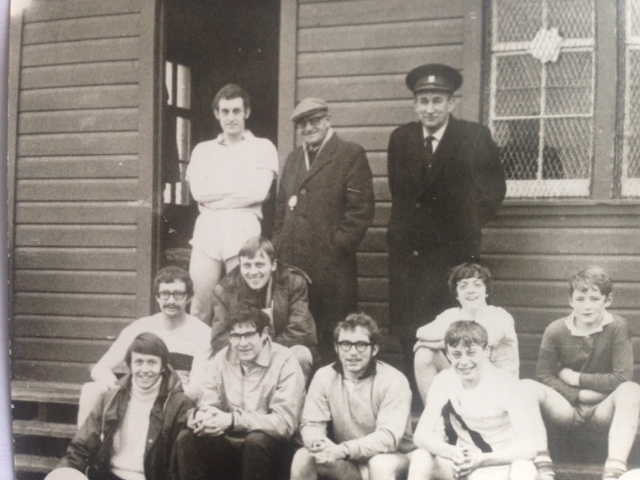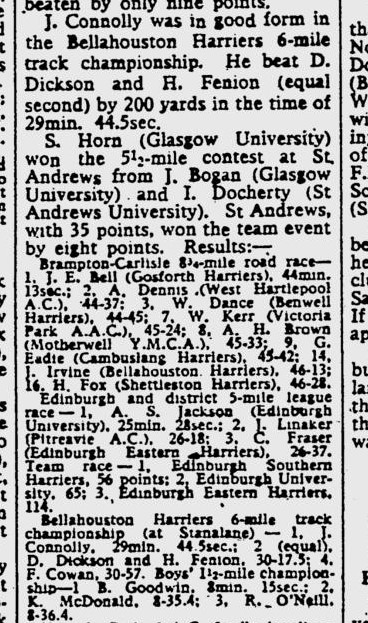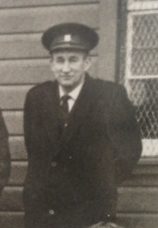One of the lesser known tracks in Glasgow was called Stanalane. There are many buildings, churches and houses known as ‘standalane’ because of their lonely position and it is possible that Stanalane Road in Thornliebank was named after one of those. Thornliebank is part of Greater Glasgow, 6 miles (10 km) south of Glasgow city centre, and just outside the city’s administrative boundaries and is now part of the East Renfrewshire local authority. It was set in woods; quite scenic but it is now gone to make way for a new road into a new housing estate. The track was home to the venerable West of Scotland Harriers – at one point contesting the position of Scotland’s number one club with a host of champions and championships to its name and many of its athletes represented Scotland internationally. It was like other small tracks and sports venues where many an athlete started in the sport, learned his trade and is fondly remembered by all who used it. Norrie Dallas of West of Scotland Harriers looks back nostalgically with this beautiful piece.
Stanalane – memories of one harrier’s spiritual home
My first thought. I don’t know much about Stanalane. And then.
I joined the West of Scotland Harriers’ Club in September 1962, prior to that I probably didn’t know Stanalane existed.The small park about 6-7 acres on two levels just south of Spiers Bridge at the start of the Stewarton Road, was looked after by Rouken Glen Park. The lower part was grassland with a wide winding cinder track leading up from the entrance to the back of the pavilion. The black cinder track, at the upper southerly end of the park, was about four lanes wide, although much wider on the long home straight and was D shaped with the pavilion being half way along the vertical leg of the D with two tight bends coming into and out of the home straight, two short straights and a long bend. I understand the track measured 441 yds. (but there are other versions of the weird distance). I was also told that it was laid out for pony trotting, but I doubt if that would be so because of the shape, which I think would be due to the configuration of the site. There was also a long jump pit and board at the far end and a shot circle, (no stop board), at the start of the home straight both outwith the track. In the centre was a cricket wicket that appeared well maintained during the season and was used for home matches by Thornliebank CC and occasionally by Weirs Recreation Second II.
Concrete steps led up from the lower end of the park to the track level. The pavilion, about 7.2 x 3m, was of brick construction to the concrete and granolithic floor level and above that timber framing clad in weatherboarding painted green and topped by a corrugated pitched roof. Timber steps the full width of the pavilion took us to decking and the two changing rooms. We always used the left-hand room which had a kitchenette with a sink, gas ring and a large gas geyser whose pilot light occasionally went out and when relit went on with a loud pop that shook the whole contraption. There was no heating or lighting of any kind. Along the gable wall was a hinged bench, closed in to the front, which gave storage space for cricket items. Behind the door and under the window there was a slatted massage table which I was told had come from a Clyde rowing club via Govanhill Baths and had been carried to Stanalane. In the back corner the glorious single shower welcomed muddy tired elated harriers who crammed in. All that was the Left Hand room, the Right Hand being similar but without the kitchenette or massage table. On my very first run with the club we also used the Right Hand room. At basement level there was a 3rd changing room with shower and was used by the Stanalane Stompers (see below) during the summer when there was a cricket match.
After winter runs which often ended in the gloaming, we were welcomed by Johnny Todd with a cup of tea and two tea biscuits which never tasted better. We paid about 4d or 6d. Johnny Todd (always Mr) and Bob Smith (always Captain re his BB connections), were both still running in the early 60s. Only once did Mr Todd refuse to let us run and that was due to very thick fog.
The pavilion was normally opened for us by Donald Fletcher (always Donald). He was the only park keeper at Rouken Glen, and was always uniformed. Other employees would be mainly gardeners I presume. Donald lived in a stone-built cottage on Rouken Glen Rd next to a park entrance ‘til retirement and Woodfarm thereafter. Sometimes he would leave us to lock up, which allowed him to get round the Glen’s gates before it was pitch black. We left the keys under the large roller that was chained and padlocked to the balusters at the LH end of the step
The Stanalane Stompers were a fluid pack of runners from a number of clubs that met on a Saturday afternoon and ran over the roads south of Stanalane by the Barrhead waterworks, Neilston and beyond covering generally about 8 1/2 to 18 miles. Gordon Porteous, Emmet Farrell (both Maryhill Harriers) and Gavin Bell (Bellahouston Harriers) were the ringleaders but Andy Forbes of Victoria Park was also a semi regular face. We would all set off together leaving the park at the far end and break into two packs after about 1/2 a mile. The last 2 1/8 miles were a welcome downhill. The sun always shone at least for the summer runs (funny how you block out grotty weather) and it was weary runners that crowded into the single shower. When cricket matches were on it was nice to relax sitting on the steps in front of the pavilion to the sound of leather on willow. Inevitably after a few balls the players would come in for a tea prepared by the ladies. Civilized game this cricket.
One Saturday afternoon Danny Cowan of Maryhill Harriers and I took a number of the boys over a hillside field on the left of the Stewarton Road just beyond Deaconsbank golf course. We had never run there before, all our country trails being on the other side of the road. We were bowling along near the edge of the field when a Land Rover stopped on the other side of the fence and a well-dressed lady alighted and asked us very politely if we wouldn’t run over the field as she was concerned about damage to the fences due to their condition. We chatted and readily acceded, the field being pretty boring anyway. On cue, Danny rested his foot on the fence rail and it snapped.
The following is a Stompers tale. Rab and George were two quite elderly runners; possibly Vicky Park. They sometimes came to Stanalane on a summer Saturday afternoon, and, always going out together after the pack had left, enjoyed a short slow-ish run together, usually being changed by the time we returned. One day I entered the park first, just in time to see George disappearing down the steps. The rest of the boys returned shortly and we realized that there was a set of extra clothes on a peg. “Must be Rab’s.” I said. I volunteered to see if I could find him and jogged up the Stewarton Road where I found him opposite the rugby club, making his way very slowly. “Hi Rab, you ok?” “Two left feet today,” he replied. “Aye, we all have runs like that sometimes.” “No, no,” he went on, “I really do have two left feet. I have two pairs of running shoes the same and in my haste to get out I grabbed two lefts, but just decided to have my run anyway.” We made our way back, one hobbling, the other mulling over the sanity of runners.
The last run from Stanalane was on Saturday 15th of January 1977, (no bugles no drums). The next week was the Western District CC at Loudon Castle, Galston and then it was Eastwood Baths. The lower park to the north is now a wooded bank at the roundabout to the east end of the Rouken Glen Road which is now re-aligned to take account of new houses and a new road layout. The flat southern end that was the site of the pavilion and track housed a new Deaconsbank Golf course club house with a driving range and is now the location of a David Lloyd sports centre.
Stanalane was everything it should be for a cross country runner or a road-runner; rural, picturesque and with basic facilities that just mirrored the sport. What more could you ask? If you stand there on a still and peaceful autumn evening you might just hear a distant pop. The geyser’s gone out again!
Norrie Dallas
Still in two relationships – one to my lovely wife and the other, the West of Scotland Harriers.
***
Hamish Telfer, a friend of Norrie’s has his own memories of the track and describes the venue as he remembers it.



